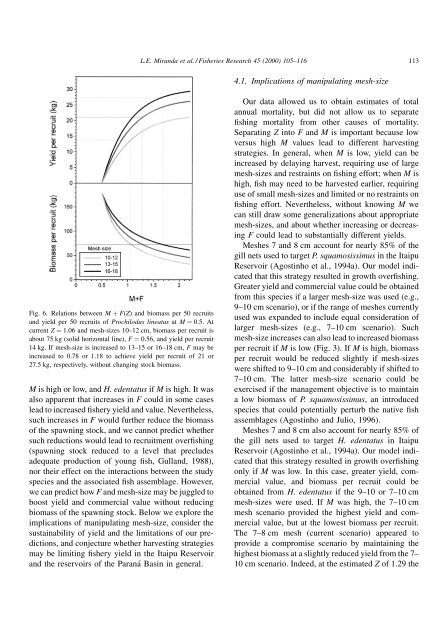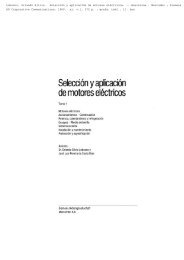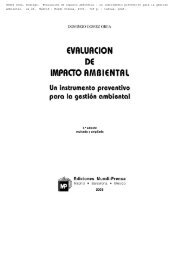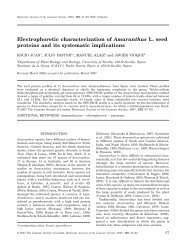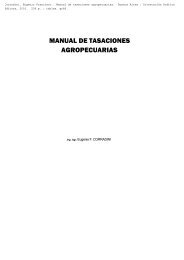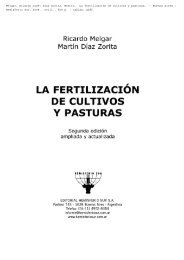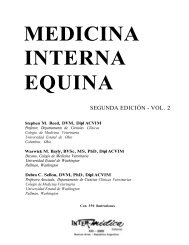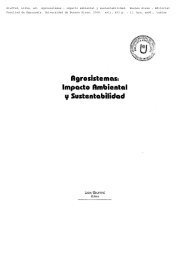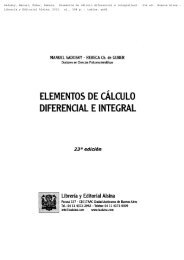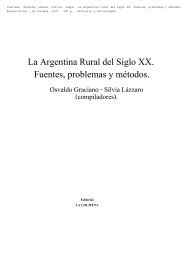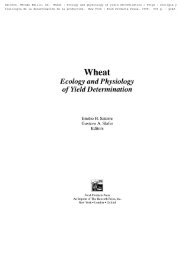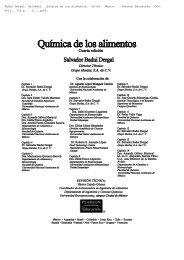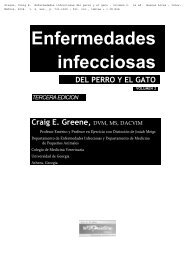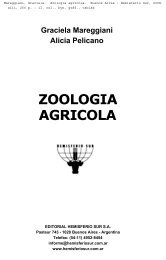Appraisal of the selective properties of gill nets and implications for ...
Appraisal of the selective properties of gill nets and implications for ...
Appraisal of the selective properties of gill nets and implications for ...
You also want an ePaper? Increase the reach of your titles
YUMPU automatically turns print PDFs into web optimized ePapers that Google loves.
L.E. Mir<strong>and</strong>a et al. / Fisheries Research 45 (2000) 105±116 1134.1. Implications <strong>of</strong> manipulating mesh-sizeFig. 6. Relations between M ‡ F(Z) <strong>and</strong> biomass per 50 recruits<strong>and</strong> yield per 50 recruits <strong>of</strong> Prochilodus lineatus at M ˆ 0.5. Atcurrent Z ˆ 1.06 <strong>and</strong> mesh-sizes 10±12 cm, biomass per recruit isabout 75 kg (solid horizontal line), F ˆ 0.56, <strong>and</strong> yield per recruit14 kg. If mesh-size is increased to 13±15 or 16±18 cm, F may beincreased to 0.78 or 1.18 to achieve yield per recruit <strong>of</strong> 21 or27.5 kg, respectively, without changing stock biomass.M is high or low, <strong>and</strong> H. edentatus if M is high. It wasalso apparent that increases in F could in some caseslead to increased ®shery yield <strong>and</strong> value. Never<strong>the</strong>less,such increases in F would fur<strong>the</strong>r reduce <strong>the</strong> biomass<strong>of</strong> <strong>the</strong> spawning stock, <strong>and</strong> we cannot predict whe<strong>the</strong>rsuch reductions would lead to recruitment over®shing(spawning stock reduced to a level that precludesadequate production <strong>of</strong> young ®sh, Gull<strong>and</strong>, 1988),nor <strong>the</strong>ir effect on <strong>the</strong> interactions between <strong>the</strong> studyspecies <strong>and</strong> <strong>the</strong> associated ®sh assemblage. However,we can predict how F <strong>and</strong> mesh-size may be juggled toboost yield <strong>and</strong> commercial value without reducingbiomass <strong>of</strong> <strong>the</strong> spawning stock. Below we explore <strong>the</strong><strong>implications</strong> <strong>of</strong> manipulating mesh-size, consider <strong>the</strong>sustainability <strong>of</strong> yield <strong>and</strong> <strong>the</strong> limitations <strong>of</strong> our predictions,<strong>and</strong> conjecture whe<strong>the</strong>r harvesting strategiesmay be limiting ®shery yield in <strong>the</strong> Itaipu Reservoir<strong>and</strong> <strong>the</strong> reservoirs <strong>of</strong> <strong>the</strong> Parana Basin in general.Our data allowed us to obtain estimates <strong>of</strong> totalannual mortality, but did not allow us to separate®shing mortality from o<strong>the</strong>r causes <strong>of</strong> mortality.Separating Z into F <strong>and</strong> M is important because lowversus high M values lead to different harvestingstrategies. In general, when M is low, yield can beincreased by delaying harvest, requiring use <strong>of</strong> largemesh-sizes <strong>and</strong> restraints on ®shing ef<strong>for</strong>t; when M ishigh, ®sh may need to be harvested earlier, requiringuse <strong>of</strong> small mesh-sizes <strong>and</strong> limited or no restraints on®shing ef<strong>for</strong>t. Never<strong>the</strong>less, without knowing M wecan still draw some generalizations about appropriatemesh-sizes, <strong>and</strong> about whe<strong>the</strong>r increasing or decreasingF could lead to substantially different yields.Meshes 7 <strong>and</strong> 8 cm account <strong>for</strong> nearly 85% <strong>of</strong> <strong>the</strong><strong>gill</strong> <strong>nets</strong> used to target P. squamosissimus in <strong>the</strong> ItaipuReservoir (Agostinho et al., 1994a). Our model indicatedthat this strategy resulted in growth over®shing.Greater yield <strong>and</strong> commercial value could be obtainedfrom this species if a larger mesh-size was used (e.g.,9±10 cm scenario), or if <strong>the</strong> range <strong>of</strong> meshes currentlyused was exp<strong>and</strong>ed to include equal consideration <strong>of</strong>larger mesh-sizes (e.g., 7±10 cm scenario). Suchmesh-size increases can also lead to increased biomassper recruit if M is low (Fig. 3). If M is high, biomassper recruit would be reduced slightly if mesh-sizeswere shifted to 9±10 cm <strong>and</strong> considerably if shifted to7±10 cm. The latter mesh-size scenario could beexercised if <strong>the</strong> management objective is to maintaina low biomass <strong>of</strong> P. squamosissimus, an introducedspecies that could potentially perturb <strong>the</strong> native ®shassemblages (Agostinho <strong>and</strong> Julio, 1996).Meshes 7 <strong>and</strong> 8 cm also account <strong>for</strong> nearly 85% <strong>of</strong><strong>the</strong> <strong>gill</strong> <strong>nets</strong> used to target H. edentatus in ItaipuReservoir (Agostinho et al., 1994a). Our model indicatedthat this strategy resulted in growth over®shingonly if M was low. In this case, greater yield, commercialvalue, <strong>and</strong> biomass per recruit could beobtained from H. edentatus if <strong>the</strong> 9±10 or 7±10 cmmesh-sizes were used. If M was high, <strong>the</strong> 7±10 cmmesh scenario provided <strong>the</strong> highest yield <strong>and</strong> commercialvalue, but at <strong>the</strong> lowest biomass per recruit.The 7±8 cm mesh (current scenario) appeared toprovide a compromise scenario by maintaining <strong>the</strong>highest biomass at a slightly reduced yield from <strong>the</strong> 7±10 cm scenario. Indeed, at <strong>the</strong> estimated Z <strong>of</strong> 1.29 <strong>the</strong>


